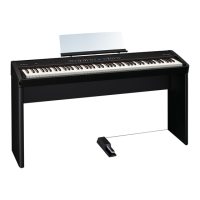About the Wireless LAN Function
Other Settings (Option)
Make settings for Wireless ID or Ad-Hoc mode.
1. Select “Wireless” ¦ “Option.”
2. Press the [ ] [ ] (SLOW/FAST) buttons to select the
parameter you want to change.
3. Press the [–] [+] buttons to change the value.
Parameter Explanation
ID (Wireless ID)
Species the nal digits of the
FP-50
’s device name
and Ad-Hoc SSID (
FP-50
) that will be shown as the
instrument in the wirelessly connected app.
Normally, you should specify “0,” but if you have
more than one of the same instrument, you can set
the Wireless ID in the range of 1–99 to change the
device name and Ad-Hoc SSID for each instrument,
as follows.
If wireless ID = 0, then “FP-50” (default).
If wireless ID = 1, then “FP-50_1.”
:
If wireless ID = 99, then “FP-50_99.”
Ad-Hoc
Species the channel (1–11) for Ad-Hoc mode.
Normally, you won’t need to change the channel.
Try changing the channel only if you have
problems connecting.
Connecting in Ad-Hoc Mode
Here’s how to connect in Ad-Hoc mode.
What is Ad-Hoc mode?
Ad-Hoc mode lets you connect the FP-50 directly to an
iPhone or other wireless device without using a wireless
LAN access point. This is a convenient way to use the FP-50
with an iPhone or other wireless device if you’re in a location
where the wireless LAN access point you normally use is
unavailable, such as when you’re away from home.
FP-50
Wireless USB Adapter
(WNA1100-RL; sold separately)
Wireless LAN
iPhone, etc.
Limitations
The iPhone or other wireless device connected in Ad-Hoc mode
will be unable to communicate with the Internet or with another
wireless device. However, an iPhone or other wireless device
that has cellular capability will be able to connect to the Internet
via the cellular connection.
Please be aware that if you use a cellular connection for Internet
connectivity, you may incur costs depending on your rate plan.
1. Select “Wireless” ¦ “Option” ¦ “Ad Hoc” and then press
the [METRONOME] button.
2. Press the [ ] (FAST) button to set Ad-Hoc mode to “ON.”
* If you decide to quit without connecting, press the [ ] (SLOW)
button.
3. When Ad-Hoc mode starts, the Ad-Hoc SSID appears on
the display. Press the [ ] (FAST) button to display the
Ad-Hoc key (a 5-digit number). Write down the value and
save it.
The Ad-Hoc key is the ve-digit number shown
on the screen.
Each piano has a dierent number.
MEMO
• The Ad-Hoc SSID appears as the “Wireless ID” setting in the
options screen.
• You can also see the Ad-Hoc SSID and Ad-Hoc key in the status
screen.
4. An iPhone or other wireless device can be connected
by selecting the Ad-Hoc SSID displayed in the screen
indicated above. (Example: iPhone [Settings]
¦
[Wi-Fi]
¦
[Select Network] to select the above Ad-Hoc SSID (FP-50).
When the password entry screen appears, enter the
above-mentioned Ad-Hoc key.)
For details on how to connect to a wireless LAN from an iPhone or
other device, refer to the owner’s manual of that device.
5. Press the [REC] button to return to function mode.
6. After ending your Ad-Hoc connection, go back to iPhone
[
Settings
]
¦
[
Wi-Fi
]
¦
[
Select Network
]
and restore the
original values.
Checking the MAC address
The MAC address is indicated on the bottom of the wireless
USB adapter (WNA1100-RL; sold separately).
45
Operation Guide Getting Ready Performing Recording Registrations Settings
Appendix

